
Anorectal disorders affect the anus and rectum. Fissures, fistulas, condyloma and hemorrhoids are among the most common anorectal conditions. In some cases, symptoms like pain, itching, burning, bleeding and/or swelling can significantly affect a patient's lifestyle. While most conditions are benign, a careful evaluation by a specialist is important to exclude an anal cancer or other serious disorder. Colon and rectal surgeons at the University of Chicago Medicine have expertise in the diagnosis and management of these disorders.
Most people experience some form of anorectal disorder during their lifetime. Primary care physicians can treat most of these disorders, however, high-risk individuals include those with HIV, roughly half of whom need surgery to remedy the disorders.Because these disorders affect the rectum, people are often embarrassed or afraid to confer with a medical professional
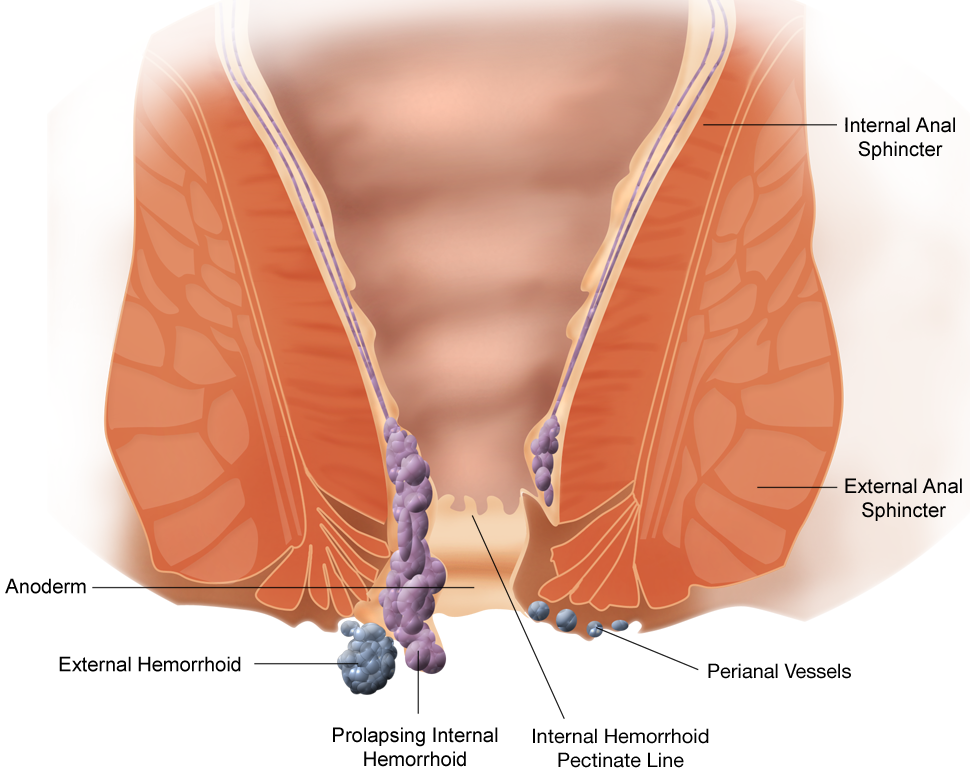
An anal fistula is an abnormal connection between the anus and the skin. On the surface of the skin around the anus, one or more ‘holes’ might be evident. These are the external openings of thin passages that tunnel down towards the anal canal.
Because very few fistulas heal on their own, surgery is needed for almost all patients who have this condition.
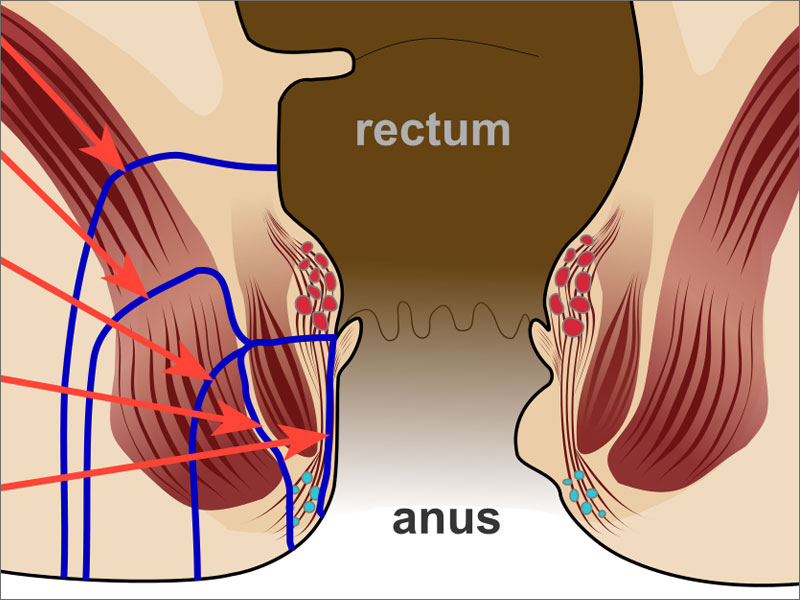
An anal fistula is usually the result of a previous abscess in the area, which has been drained (of pus) but does not fully heal. This results in persistent or intermittent discharge of pus, blood or mucus. Usually, there is no much pain, although an abscess can sometimes recur.
Surgery to treat anal fistulas is generally a very safe operation and carries few risks, but (as with any surgical procedure) complications can occur. Since fistulas are closely linked to the muscles that control the passage of faeces and gas, Surgeons are very careful in the decision-making process concerning the nature of the surgery performed because there is a small risk of damage to these muscles. For the majority of patients, the laying open of the fistula does not involve a significant portion of the anal muscles being cut, and the loss of continence is not a risk. Nevertheless, any disturbance of the anal sphincter muscles can lead to some degree of change in the ability to control wind, liquid and, very occasionally, solid faeces from the back passage.
The details of any operation will be explained to you beforehand. In general, before your admission for surgery, you should be on a high-fibre diet and have a fluid intake of at least 6-10 glasses of water daily. This is to keep your bowel motion soft. You are advised to take 2 tablets of Dulcolax night before your surgery. In some instances, The nurse may give you an enema to empty the bowel (depending on the type of surgery you will have).If you are overweight please try to reduce. This will reduce the anaesthetic risk and will optimise your recovery.
An anal fissure is a split in the skin at the opening of the anus, which leaves exposed some of the muscle fibres of the anal canal. Pain results from the recurrent opening of the wound when the bowels are opened, and it is often accompanied by bleeding. In addition, the inner circle of muscle in the anal canal (called the internal sphincter) goes into spasm: this makes the pain worse and can prevent healing. Anal fissures are different from haemorrhoids and have no relationship with cancer.
The most commonly used operation to treat anal fissures is called a lateral anal sphincterotomy. It involves a part of the internal sphincter muscle being cut, which relieves the spasm of the muscle, stops the pain and allows the fissure to heal. Occasionally a tag can develop at the inside edge of a long-standing fissure, and this can be removed at the same time. It is not usually necessary to remove or suture the fissure itself. The operation is very effective, but carries a small risk of some change in your ability to control wind from the back passage; in most cases, this problem will resolve completely, but in a small proportion of people, it can be permanent.
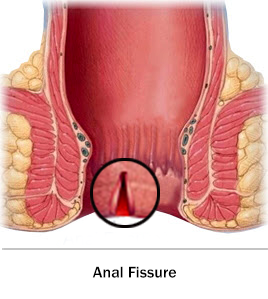

A sinus tract is a small abnormal channel (like a narrow tunnel) in the body. A sinus tract typically goes between a focus of infection in deeper tissues to the skin surface. So the tract may discharge pus from time to time onto the skin.
A pilonidal sinus is tract which commonly contains hairs. It occurs under the skin between the buttocks (the natal cleft) a short distance above the anus. The sinus track goes in a vertical direction between the buttocks. Rarely, a pilonidal sinus occurs in other sites of the body.
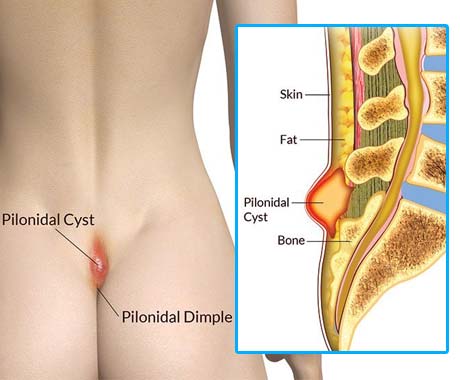
The exact cause is not clear. There are various theories. For example, one theory is that the problem may develop from a minor congenital or hereditary abnormality in the skin of the natal cleft. This may explain why the condition tends to run in some families. Part of the abnormality in this part of the skin may be that the hairs grow into the skin rather than outwards.
Another theory is that you develop skin dimples (skin pits) in the skin between the buttocks. These may develop from damaged hair follicles (the small structures under the skin that make the hairs) due to local pressure or friction. Because of local pressure, growing hair in the natal cleft may get pushed into the skin pits.
Whatever the cause, once hair fragments become ‘stuck’ in the skin they irritate the skin and cause inflammation. Inflamed skin quickly becomes infected and so a recurring or persistent infection tends to develop in the affected area. The infection causes the sinus to develop which often contains broken pieces of hair.
(A similar condition occurs between the fingers of hairdressers caused by customers’ hair entering moist, damaged skin.)
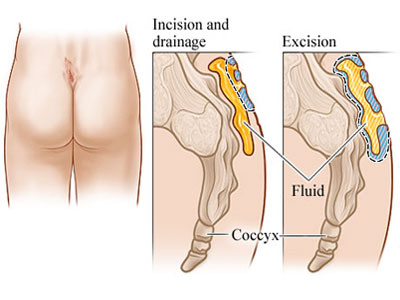
The most commonly used operation to treat anal fissures is called a lateral anal sphincterotomy. It involves a part of the internal sphincter muscle being cut, which relieves the spasm of the muscle, stops the pain and allows the fissure to heal. Occasionally a tag can develop at the inside edge of a long-standing fissure, and this can be removed at the same time. It is not usually necessary to remove or suture the fissure itself. The operation is very effective, but carries a small risk of some change in your ability to control wind from the back passage; in most cases, this problem will resolve completely, but in a small proportion of people, it can be permanent.
Haemorrhoids are swellings on the inside of the anal canal, the short muscular tube that connects the rectum (back passage) with the anus. They are round swellings that can reach the size of a grape. They are not varicose veins and are also known as ‘piles.’
Although haemorrhoids develop inside the anal canal, they can hang down outside of their normal place.
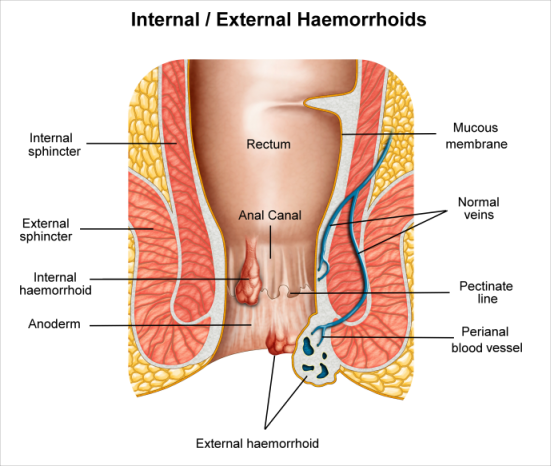
Untreated haemorrhoids can drop down outside the anal canal and strangulate causing pain. Haemorrhoids can cause leakage of mucous, inflammation and irritation of the skin around the anus. Untreated haemorrhoids can also bleed, so you could become anaemic.
Your blood pressure, pulse and wounds will be monitored closely over the first few hours. You will normally be able to start drinking shortly after the procedure, and can start eating as soon as you are hungry. You will normally be able to get out of bed a few hours after surgery, although the nurses will assist you the first time.
Some pain is to be expected. The nurses will monitor how you are feeling and give you painkillers if required. If an anal plug has been inserted this will usually be removed a few hours after surgery. If a dissolvable anal plug has been used this will be passed on your first bowel movement.
A small amount of bleeding is also to be expected. The nurses will monitor the wound site and if necessary provide pads to protect your clothes from soiling. If your operation is planned as a day case you can go home as soon as the effect of the anaesthetic has worn off.
A general anaesthetic can temporarily affect your coordination and reasoning skills so you will need someone to take you home. During this time it is also important that you do not operate machinery or drive.
Haemorrhoids can return after any form of treatment, but they are less likely to return after having a haemorrhoidectomy. If they do return another haemorrhoidectomy or other forms of treatment may be necessary.